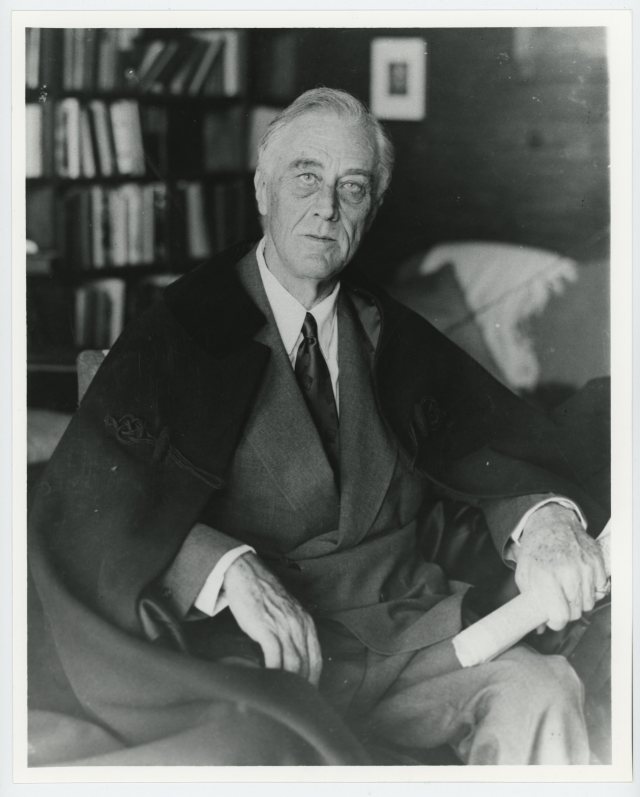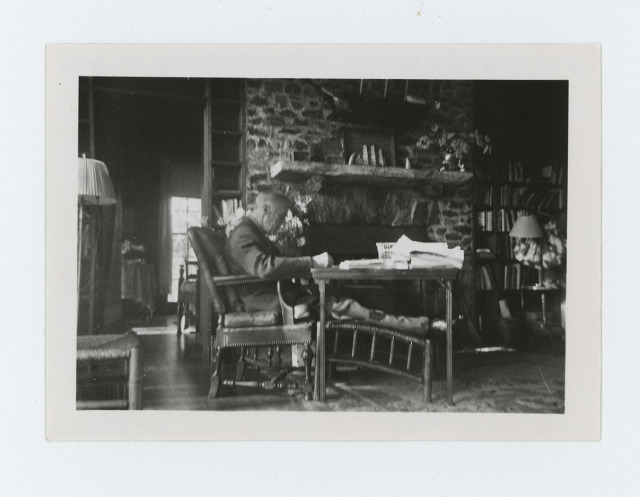#fdrs final campaign
REMEMBERING FDR
FDR’s death shocked the nation. Millions of American never forgot where they were and what they felt when they learned the news. Many reflected on how deeply his presidency had impacted their lives.
In 2005, the Franklin D. Roosevelt Presidential Library and Museum asked a group of Americans to talk about their memories of FDR’s death and reflect on his legacy. This program features excerpts from their recorded remarks.
This film, “Remembering FDR,” is also featured in the current exhibition “FDR’s Final Campaign” open now.
To keep updated on our At Home with the Roosevelts programs, subscribe bi-weekly E-Newsletter - https://lp.constantcontactpages.com/su/mwZHCz3/athomepage
FDR’s Last Days
 ALT
ALT ALT
ALTFDR’s last days were spent quietly at Warm Springs. The President sat for a portrait by artist Elizabeth Shoumatoff and conversed casually with his guests. On April 10 and 11, Shoumatoff’s assistant made a series of photographs of the President to assist her with her painting. They last images ever shot of him.
On April 10, FDR and Lucy Rutherfurd took a leisurely drive to Dowdell’s Knob, a rocky outcrop that offered a broad view of the surrounding countryside. Roosevelt had visited it many times during the difficult early years of his struggle with polio. It remained a favorite place to sit and reflect.
International issues still forced their way into the secluded world of the Little White House. Soviet actions in Eastern Europe threatened to divide the Allies just as victory was in sight in Europe. Seeking to maintain the alliance and ensure the success of the UN conference in San Francisco, FDR worked to smooth the waters. “I would minimize the Soviet problem as much as possible,” he wrote to Winston Churchill on the morning of April 11, “We must be firm, however, and our course thus far is correct.“ Later that dictated a speech he was to make on April 13. That evening, he dined with his Treasury Secretary Henry Morgenthau, Jr. Morgenthau was shocked by his old friend’s haggard appearance. Before he departed that night, FDR told him about his upcoming trip to the UN conference. He would appear there in his wheelchair, he told Morgenthau.
—
 ALT
ALT ALT
ALT ALT
ALTThese five photographs, shot on April 10-11, 1945, are the last images of President Roosevelt ever taken. They reveal the dire state of his health. The photographs were made by Nicholas Robbins, an assistant to artist Elizabeth Shoumatoff. Shoumatoff came to Warm Springs in April to paint a portrait of the President. She instructed Robbins take these photos to help her complete the portrait at her studio.
The three photographs of FDR outside his Warm Springs cottage were shot on April 10. The other two shots—taken inside the cottage—were made on April 11.
See these photographs and more in our current exhibition "FDR’s Final Campaign”.
WARM SPRINGS, APRIL 1945
 ALT
ALTPresident Roosevelt spent most of March at the White House and his Park estate. During these weeks he laid plans for the April conference Francisco that would draft a charter for the United Nations organization President took particular care to assemble a bipartisan U.S. delegation conference. These efforts were complicated by growing concerns about Soviet behavior in Eastern Europe, where Stalin was ignoring agreements at Yalta. Winston Churchill pushed Roosevelt to take a more confrontational approach with Stalin, but FDR counseled patience. He did not want to jeopardize Soviet participation in the United Nations, believing it offered the best hope for curbing Stalin’s bad behavior.
On March 29, a weary President departed Washington for a vacation in Warm Springs, Georgia. Eleanor Roosevelt and his daughter, Anna, remained in Washington. Both hoped FDR would rest and recover his strength at the “Little White House,” where he had often done so in the past. Roosevelt cousins Laura Delano and Margaret Suckley and his cardiologist, Dr. Harold Bruenn, accompanied him to Georgia. On April 9, they would be joined by another visitor-Lucy Mercer Rutherfurd.
At Warm Springs, FDR enjoyed the warm early Spring weather. Each day the President reviewed and signed papers. But there was ample time for car rides, his stamp collection, quiet meals, and rest. Roosevelt also began planning his trip to attend the opening of the UN conference on April 25.
 ALT
ALTSee these photos and more from FDR’s final days in our current exhibition, “FDR’s Final Campaign.”
FDR AND MARGARET SUCKLEY
Understanding Franklin Roosevelt’s inner motives and true intentions is a difficult task. The President did not keep a diary and rarely revealed his private thoughts to anyone. Margaret “Daisy” Suckley, a distant cousin, was a rare exception. To her, he confided some of his most private thoughts.

NPx 73-113:36: Cruise on USS Potomac, FDR with Margaret Suckley, March 18, 1939.
Suckley lived near Hyde Park and grew friendly with FDR during the 1920s. During the mid-1930s their friendship deepened and she became a frequent visitor at Springwood and the White House. Quiet, unassuming, and discreet, Daisy provided FDR with companionship and relaxing conversation that eased the burdens of the presidency. Roosevelt felt free to talk with her about his illness, possible retirement, and hopes for the future—including the United Nations organization.
Suckley kept an extensive diary that remained hidden until after her death in 1991. It offers rare insights into FDR’s thoughts—especially during the often lonely months of his final year. Daisy was aware of his frail health and doubts about running for a fourth term. In her May 22, 1944, diary entry, she carefully recorded his uncertain response when she asked if he’d decided on a running mate: “I haven’t even decided if I will run myself,” he admitted. “If I know I am not going to be able to carry on for another four years, it wouldn’t be fair to the American people to run for another term.”
Learn more about FDR and Daisy and see pages from her diary in our current exhibition FDR’s Final Campaign.
